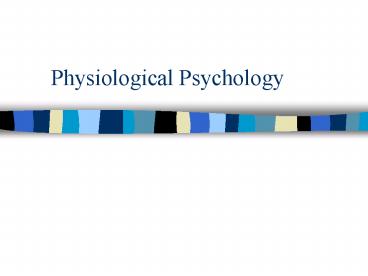Physiological Psychology PowerPoint PPT Presentation
1 / 12
Title: Physiological Psychology
1
Physiological Psychology
2
Consciousness and the Mind-Body problem
- Aristotles statement of the problem
- Two or one?
- Dualism Two kinds of stuff
- Cartesian dualism, or one-way interactionism
- Reciprocal interactionism
- Occasionalism (Nicholas Malebranche, 1638-1715)
- Psychophysical parallelism (Gottfried Wilhelm
Leibnitz, 1646-1716)
3
The mind-body problem Monism One kind of stuff
- Materialism Either mind does not exist
(Descartes view of animals) or it depends for
its existence on matter (Julien Offray de la
Mettrie, 1709-1751) - Mentalism or immaterialism
- Theological mentalism Berkeley
- Solipsism
- Mind-stuff theory (Morton Prince, 1854-1929)
4
The identity position
- Double aspect theory (Spinoza) is still dualist.
- Dual aspect monism (George Henry Lewes,
1817-1878) - But Lewes insisted that mental and physical
descriptions are not interchangeable, avoiding
reductionism. - Panprotopsychic identism (Rensch, 1971)
5
Other points of view
- Emergent property position (Sperry)
- Epiphenomenalism
- Evolutionary psychology and the question of
consciousness.
6
Contributions from physiological psychology
- Penfield and brain stimulation studies
- Blindsight
- Split-brain studies
- Left hand bored with book
- Left hand makes obscene gestures
- Wife-beating/protecting
- Is consciousness based, then, in language?
7
Biological roots of physiological psychology
- Andreas Vesalius(1514-1564)
- Christopher Wren (1632-1723) and tracing
- Thomas Willis (1621-1675), De cerebre anatome
- Emilio Golgi and Santiago Ramon y Cajal Staining
8
The empirical assessment of Descartes
- Swammerdam and Archimedes principle
- Luigi Galvani and Allessandro Volta
- Hermann von Helmholtz
- But the reflex arc remains.
9
Physiological roots
- Bell (1812) and Magendie (1823)
- Johannes Muller and the Doctrine of Specific
Nerve Energies - The neuron doctrine
- Pierre Flourens and Paul Broca Ablation
- Gustav Fritsch and Eduard Hitzig ESB
- Charles Sherrington and the synapsis
10
De cerebri anatome
- One of Christopher Wrens drawings for Thomas
Williss groundbreaking work on the anatomy of
the brain, published in 1664. (Contrast enhanced)
11
On the workings of the human body
- A famous illustration from Andreas Vesalius
groundbreaking work on human anatomy, published
in 1543. (Contrast enhanced)
12
Bells anatomy
- Charles Bells neuroanatomy of the early 19th
century adds color, but retains the realism of
Vesalius. (Contrast enhanced, picture darkened)

